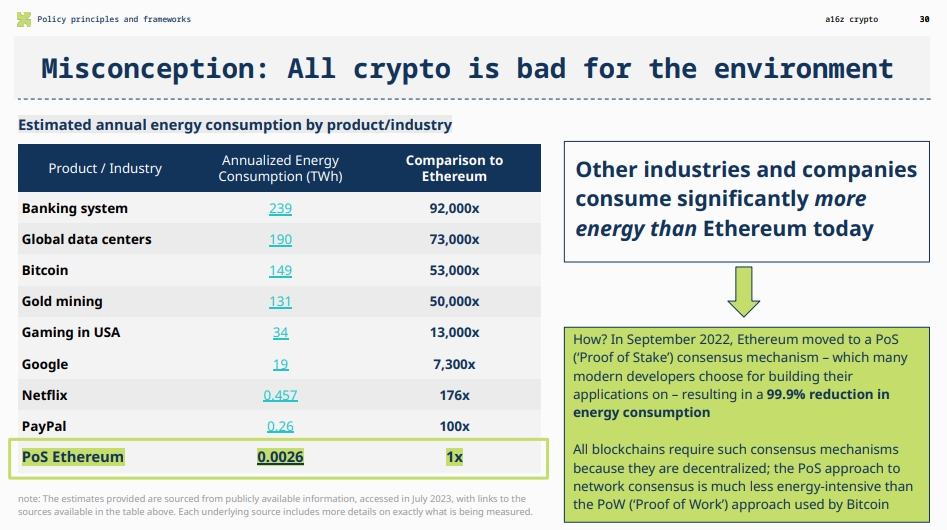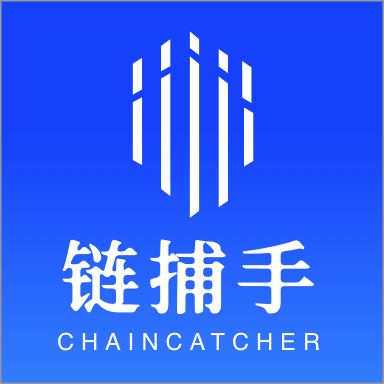Original source: a16z: 2023 state of crypto policy spotlight - What’s really going on in crypto and web3?》
Original author: a16z crypto
Original compilation: Cookies bayemon.eth, ChainCatcher
a16z Note: The views expressed in this article belong to the individual AH Capital Management, LLC (a16z) personnel cited and do not represent the views of a16z or its affiliates. The information provided is obtained from third party sources, including portfolio companies of funds managed by a16z. While sources are generally reliable, a16z has not independently verified such information and makes no representation as to the enduring accuracy of the information or its applicability to a particular situation. This content is for informational purposes only and should not be relied upon as legal, business, investment or tax advice.
Encryption and Web3 world events inventory
Andreessen Horowitz’s annual “State of Crypto” report shares data on Web3 activity and innovation. The November 2023 Policy Spotlight collates insights from the report for U.S. policymakers and others interested in the state of encryption policy today. The report includes:
Part 1: Why Web3 is so important
Web3 is a more consumer-friendly form of the Internet, with benefits and uses that extend far beyond financial services.
Part 2: Current status of the encryption industry
Cryptocurrencies have become indispensable due to their ability to transcend party lines and identities, yet the United States may be losing its lead.
Part 3: Policy principles and framework
How do you stay competitive in emerging technological innovations while protecting consumers?
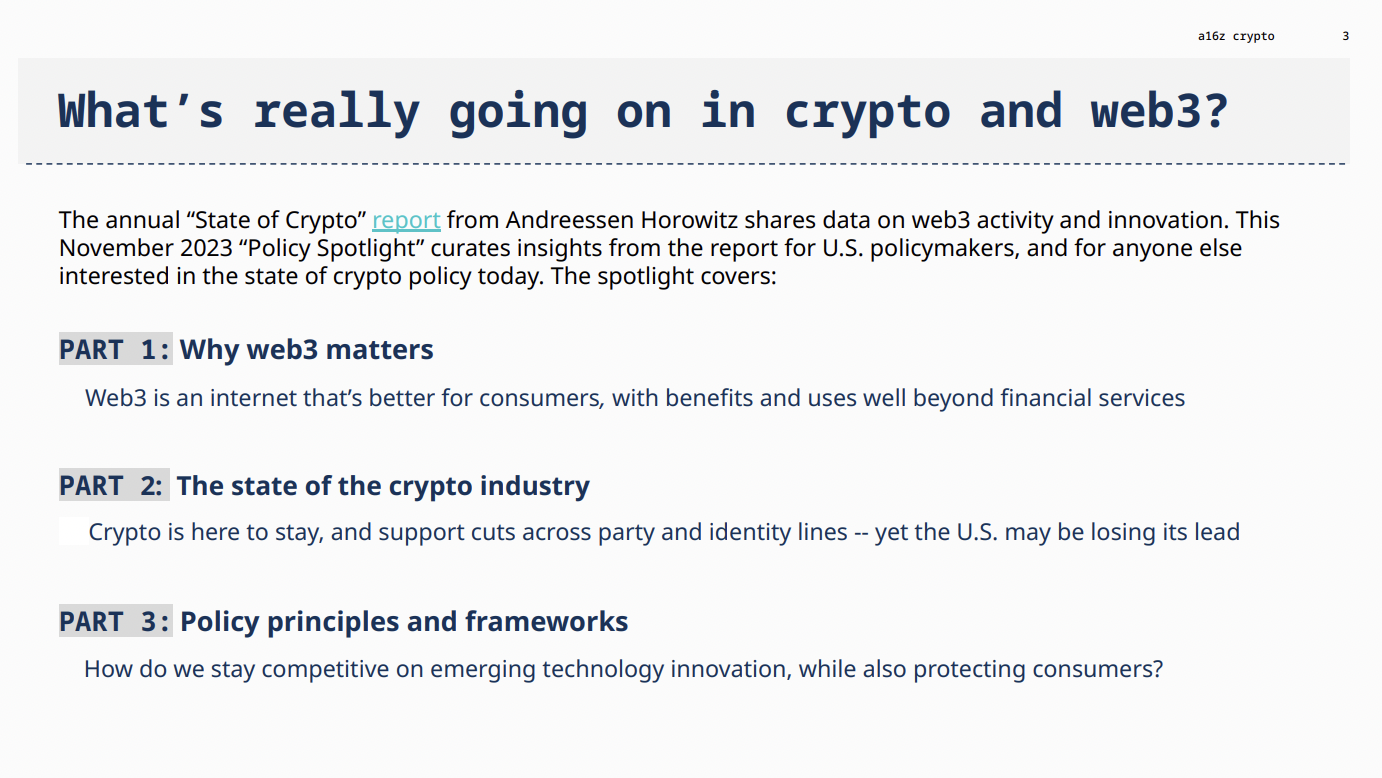
Part One: Why Web3 is so important
The Internet is one of the most important technological innovations in human history. Yet it often disappoints the consumers, creators, and developers who rely on it.
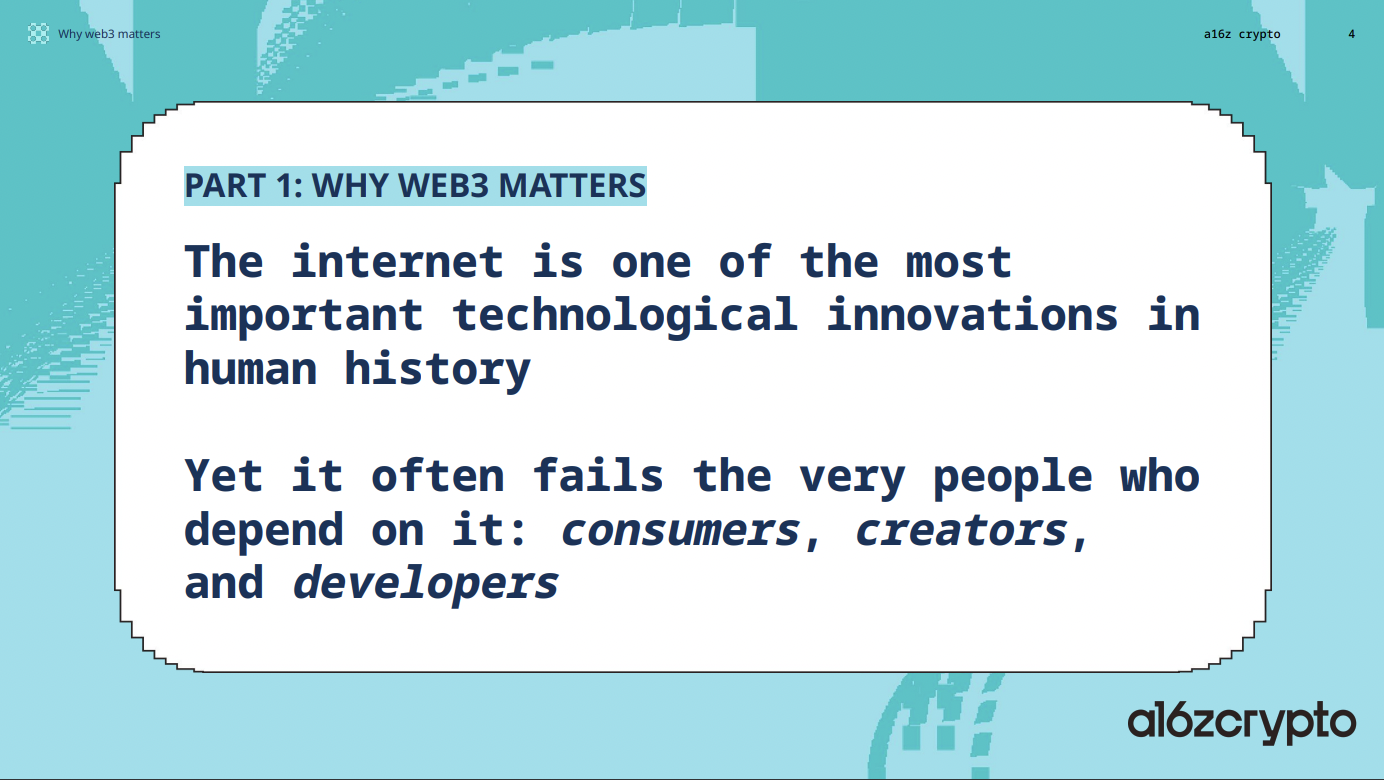
Adoption of Web3 technologies is evolving in ways that help consumers
Web1(1990 - 2005)
Loosely governed by various agencies Open technologies (protocols) i.e. anyone can build on them, like email (based on SMTP) and web (based on HTTP) Value does not accrue to the network
Web2(2005 - 2020)
Managed by companies Centralized, isolated platforms where decisions can be made by single individuals (e.g. social networks) Value is accumulated in a few large tech companies rather than in the value creators themselves
Web3 (2020 to present)
Decentralized, interoperable services owned and maintained by the network (e.g. blockchains such as Bitcoin, Ethereum, etc.) managed by the community. Value is accumulated in the users, builders and community who contribute to the network: Development authors, entrepreneurs, creators, fans and other consumers.
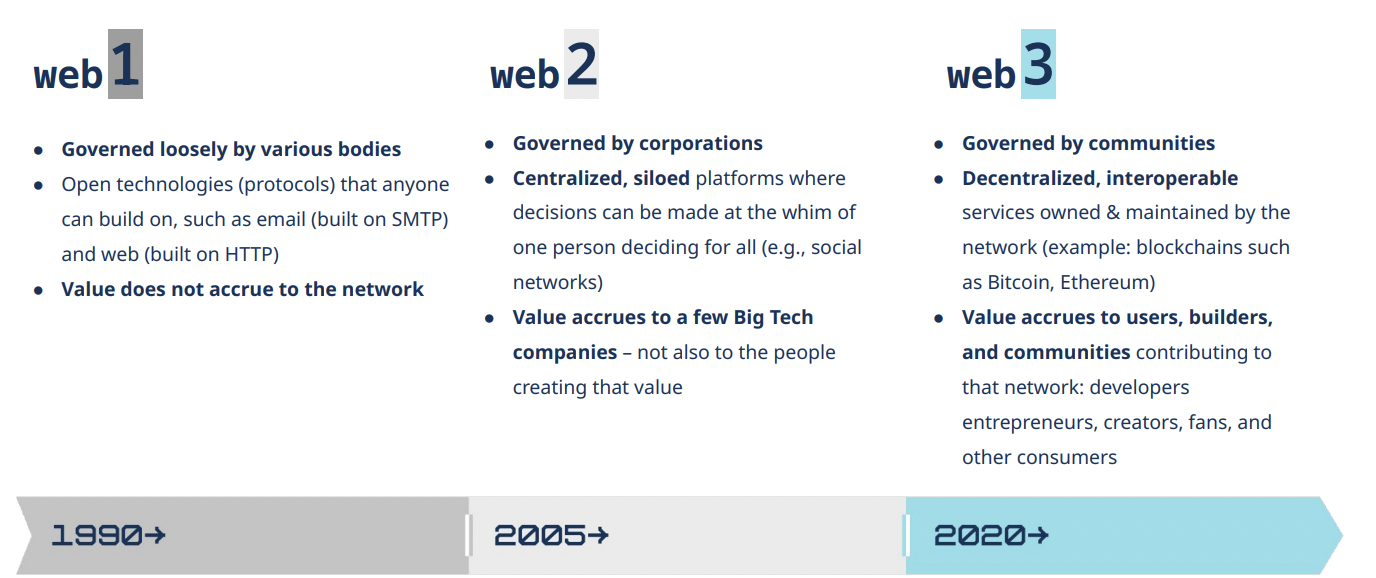
Web2 technology giants intend to monopolize, Web3 emphasizes decentralization
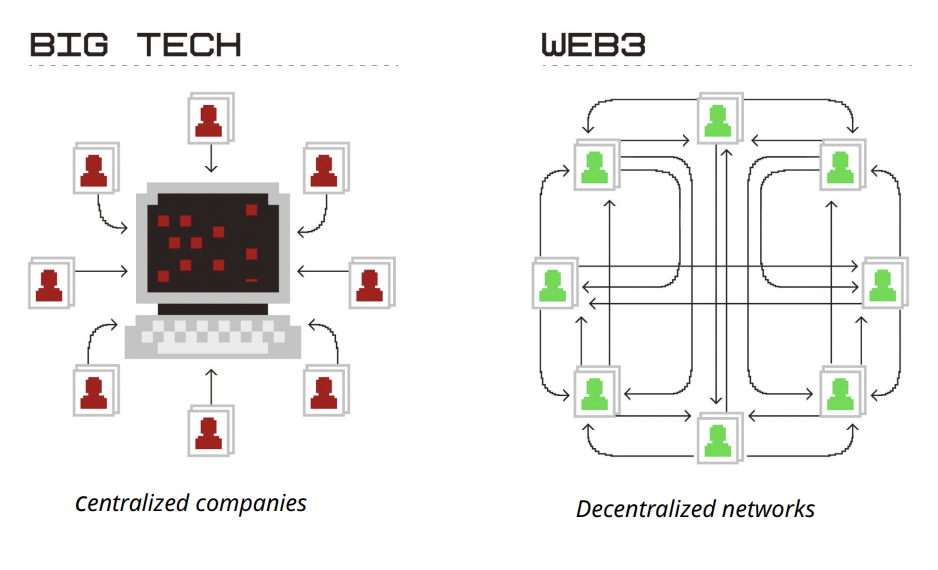
Only three companies, including Facebook, Google, and Twitter, contribute 1/3 of the world’s Internet traffic
Only five companies, Amazon, Apple, Facebook, Google, and Microsoft, account for 50% of the total market value of the Nasdaq 100 Index (only 25% ten years ago)
Web3 delivers web value to more people through ownership
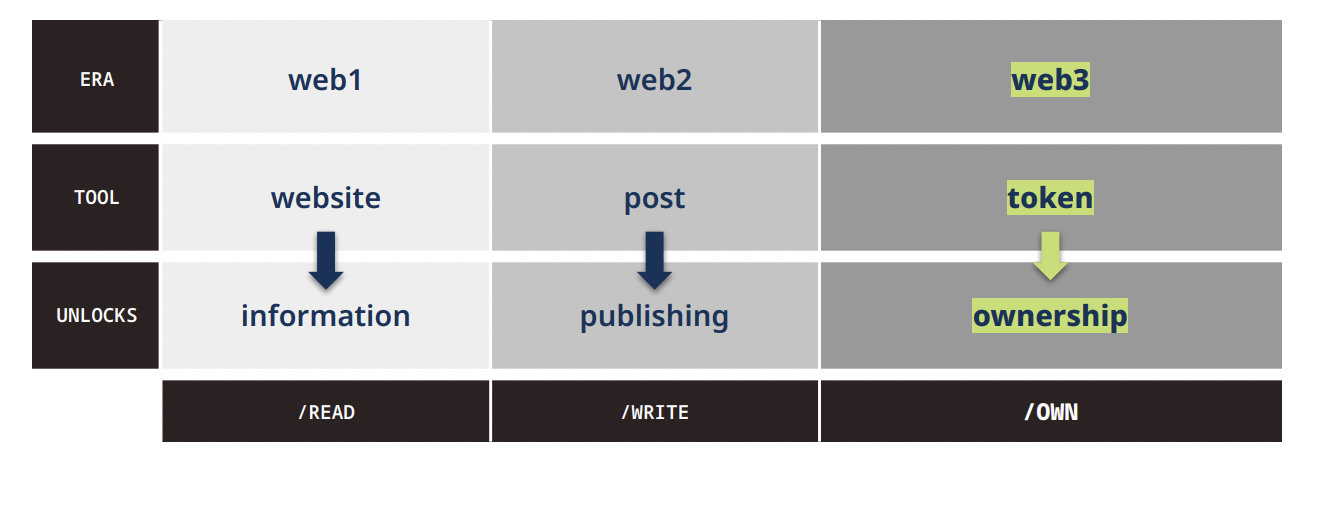
Token: the cornerstone of Web3
Tokens are “units” of ownership: Tokens can represent ownership of anything: digital (like art, tickets, or game items); or physical (like clothing, experiences, or even real estate).
Tokens are the basic building blocks: Tokens are not financial instruments in nature. Just like websites in Web1 and posts in Web2, tokens are the basic building blocks in the process of building the Web3 network.
Tokens give people rights: Tokens are a new way for people to control their digital identities on different platforms and services, similar to the property rights talked about on the Internet.
The uses of tokens go far beyond speculation…
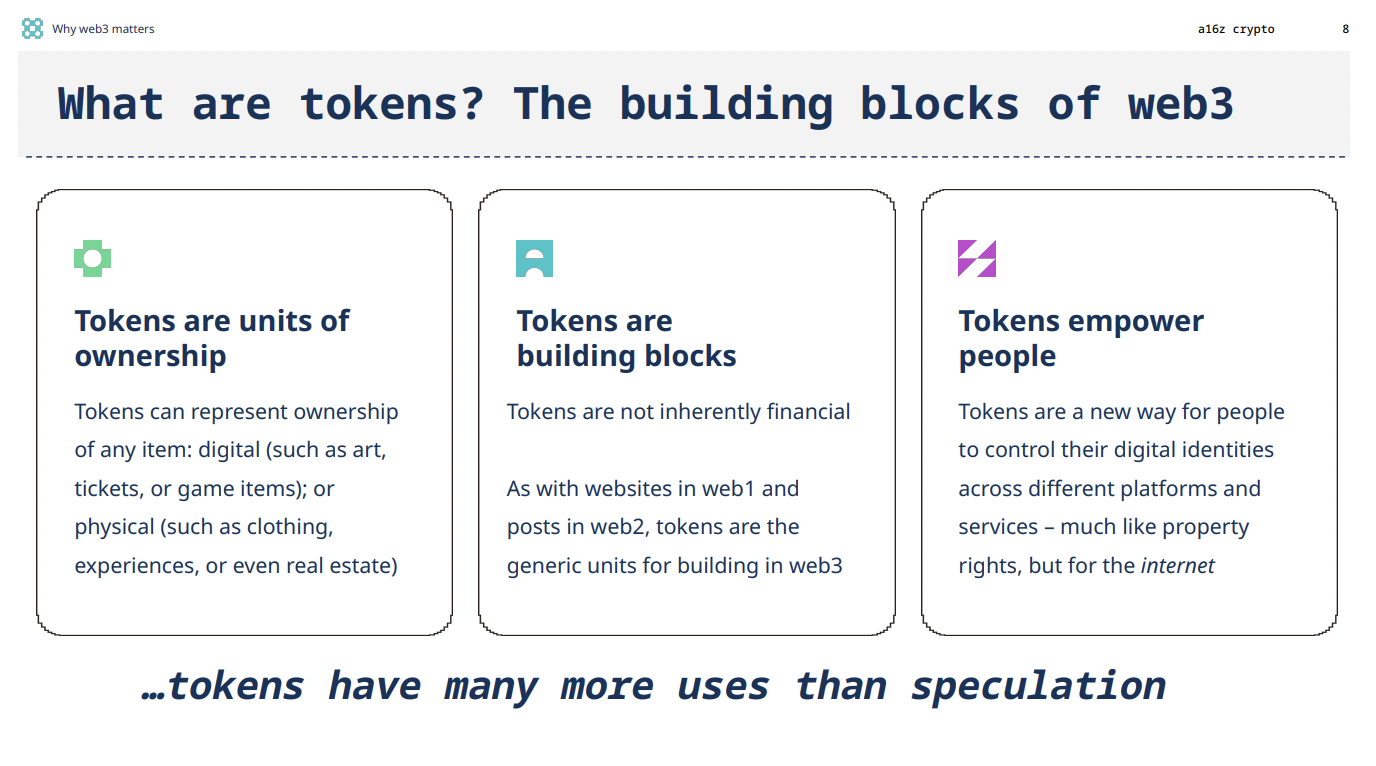
Blockchain should be a powerful computer, not a casino for speculation
There is an essential difference between a world where speculation is the purpose and a world where computers are products.
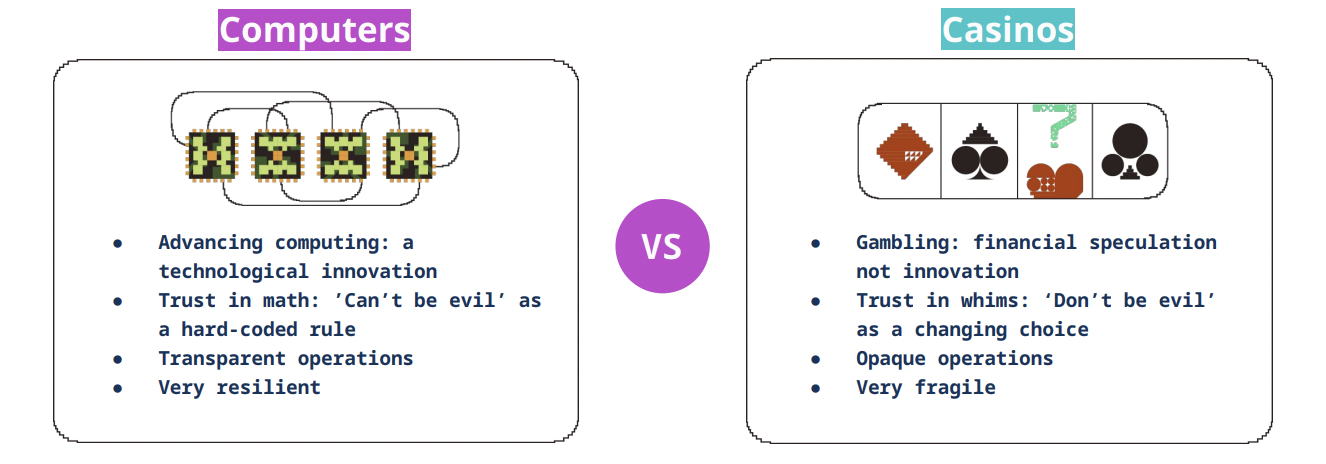
computer
Promoting the development of computer science as a technological innovation
Based on digital trust, “don’t be evil” is hard-coded as a rule
High operational transparency
Strong toughness
casino
Gambling is financial speculation, not innovation
Profit-Based Trust, “Don’t Be Evil” as a Changing Choice
Opaque operations
very fragile
Community-governed networks will become the next generation of the internet
Advantages: As a new type of computer, what unprecedented capabilities does blockchain have?
Protecting consumers as artificial intelligence (AI) continues to advance
Fighting high-quality AI-based counterfeiting: In a world filled with endless high-quality AI-generated counterfeiting, cryptography can help trace the authenticity and origins of what we face.
Democratizing AI innovation: Rather than relying on large tech companies with the most data and computing resources, crypto can democratize access to these resources, benefiting more builders.
Uncovering the “black box” of AI: AI doesn’t have to be a black box where no one knows what’s going on or where the data comes from. Encryption technology can make the data used by AI more transparent and auditable, while protecting data privacy.
Data ownership vests with individuals: Encryption technology can enforce data privacy in AI models while also helping companies provide incentives for consumers and creators for the data they (already) contribute.
Upgrade of traditional privacy system
Apple charges up to 30% on mobile consumer purchases. Apple has huge pricing and decision-making power in mobile distribution. Crypto can lower the fees platform owners charge from users (as a percentage of platform revenue), increase competition, and provide consumers with more choice.
People spend $647 billion on remittances every year, at an average cost of 6.25%. Crypto can eliminate unnecessary middlemen and slash up to $40 billion in international transaction fees.
Only 18% of social media users trust the data protection services provided by Facebook. In Web3, people own their data - from the posts they create to the music they make to the networks they build. Whats more, they can take their network and data from one platform to another.
Encryption technology solves current pain points
Identity Matters: Rather than relying on large platforms to manage user identities, Spruce empowers people to control and own their identities. Organizations can also manage the lifecycle of digital credentials (just like the DMV in California is doing with mobile drivers licenses).
Creator monetization problem: Only 18,000 musicians (less than 0.2%) on streaming services make more than $50,000 a year. Sound eliminates the middleman and enables artists to monetize directly with their fans.
The problem with carbon neutrality: The voluntary carbon credit market system is opaque and inefficient. With Flowcarbon, more money can flow directly to important environmental projects.
Censorship and deplatforming issues: Biased platform leaders can dictate the rules and reach of social networks. But decentralized social networking protocol Farcaster lets users choose between apps while easily moving (and owning) their data.
Infrastructure issues: Lack of competition in the telecommunications industry results in higher prices and uneven coverage. Helium is working to deliver 5G everywhere through decentralized wireless infrastructure at a fraction of traditional costs.
Opportunities for online collaboration: narrative, production, and division of responsibilities for intellectual property. Story Protocol and Adim provide open infrastructure that helps people co-write, remix, collaborate and create characters while protecting intellectual property and compensating creators.
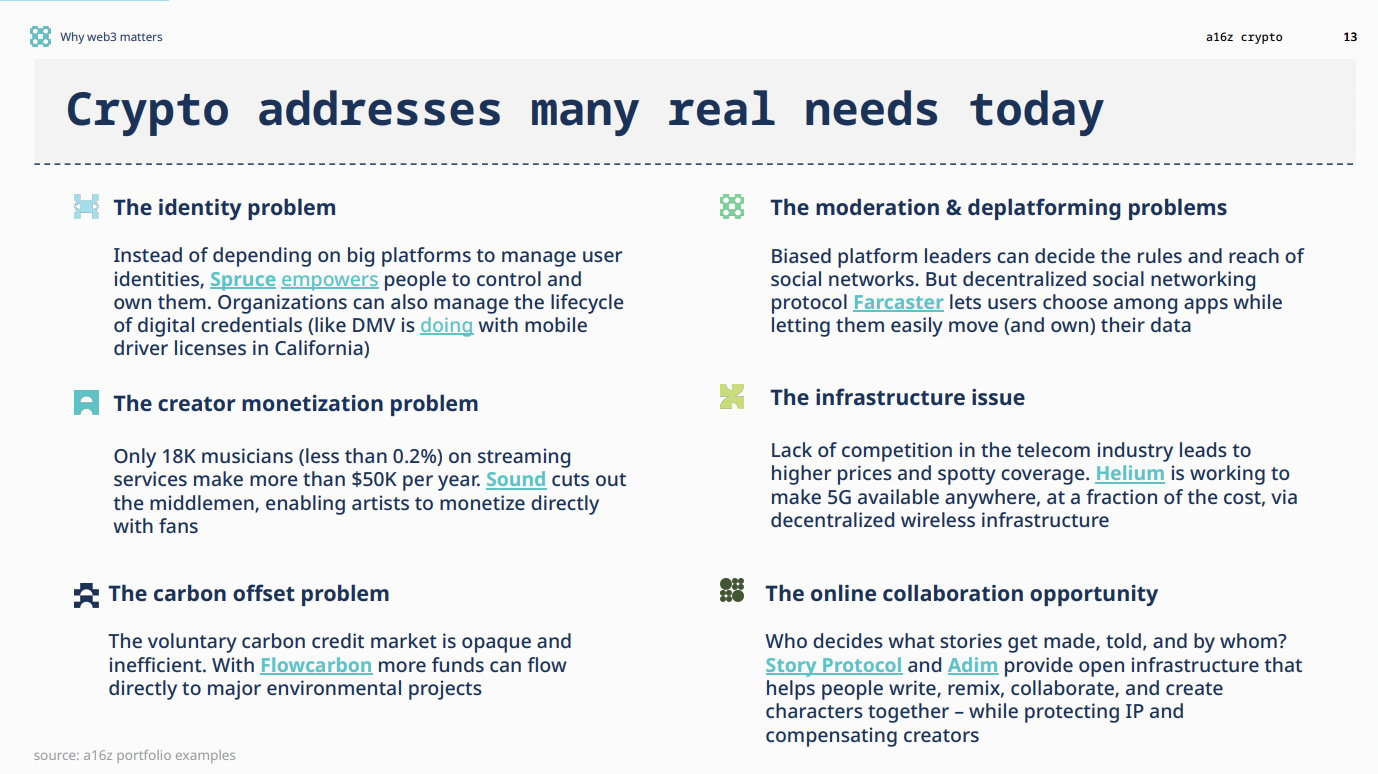
Part Two: Current State of the Crypto Industry
The Web3 era has arrived: millions of Americans hold cryptocurrencies and usage is growing.
More than 40 million Americans hold crypto assets, and there are no clear restrictions on party affiliation or identity.
16% - 20% of U.S. adults (approximately 40-50 million people) have purchased cryptocurrency
The use of cryptocurrencies is increasing. Despite price fluctuations, we have seen the number of active users maintain at least double-digit growth for four consecutive years.
This data tracks the number of unique active (sending) addresses across all blockchains, including Ethereum, Polygon, Solana, Avalanche, Fantom, Celo, Optimism, Base, and Arbitrum. Note: 1 address does not necessarily correspond to 1 person. Source: Nansen Query, CoinMarketCap
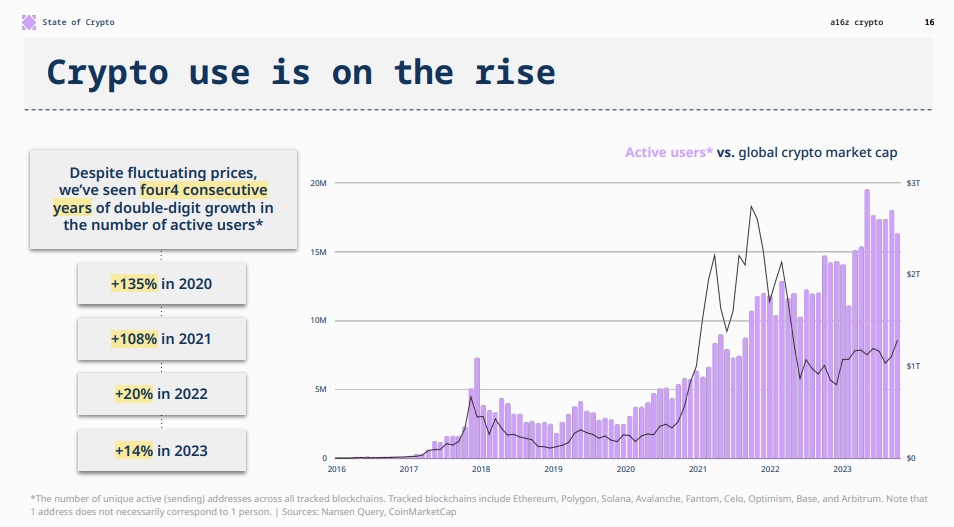
There are an increasing number of institutions researching cryptocurrencies and driving progress in other fields. 21,000+ crypto publications dedicated to solving top issues:
Privacy-preserving financial compliance: using zero-knowledge (rapidly moving from theory to practice)
Fighting disinformation: Using encryption to prove authenticity
Checks and Balances in Artificial Intelligence: Using Blockchain Networks and Decentralization
Blockchain performance and security: Cryptoeconomic game theory, networking, and more.
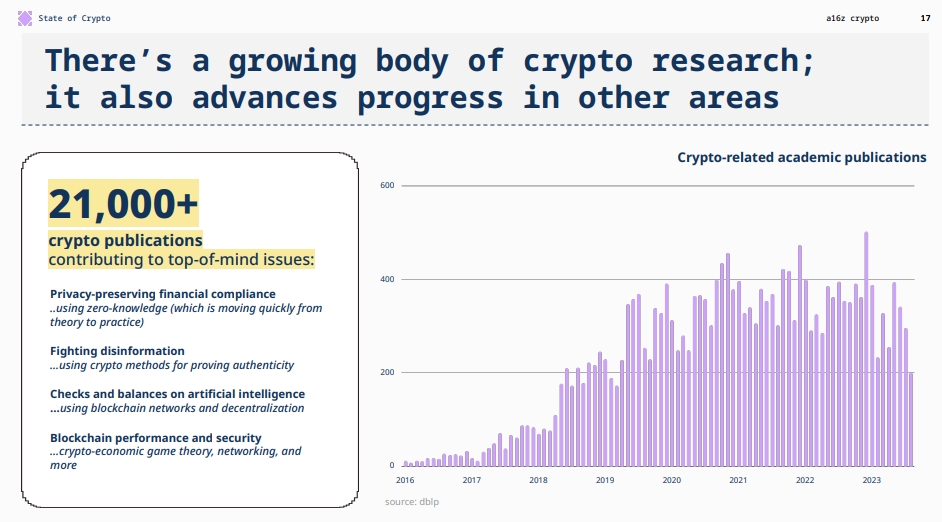
The importance of American leadership
Leading web3 innovation will keep America competitive, which also involves national security issues.
The United States has always been a beacon of technological innovation, but it may lose its leadership in web3
Percentage of U.S. cryptocurrency developers (left), percentage of global traffic to U.S. cryptocurrency websites (right)
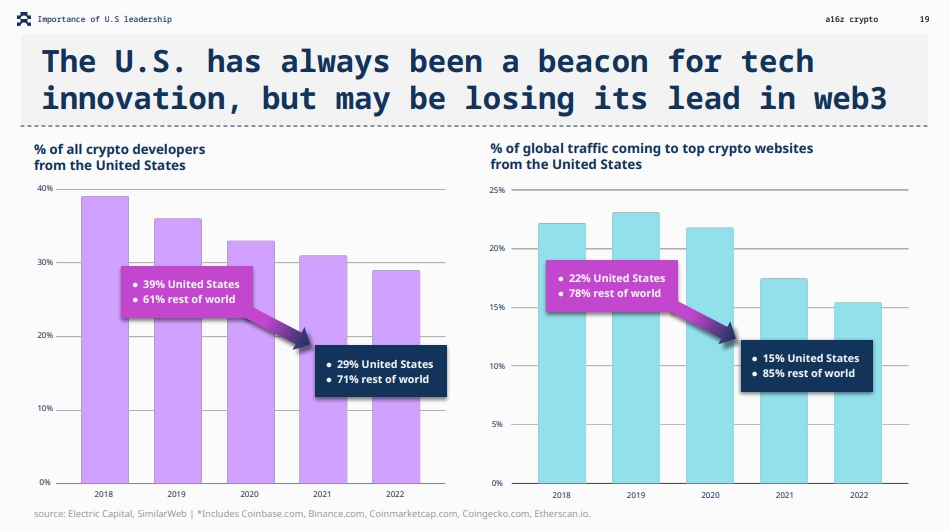
More developers are working on crypto projects outside of U.S. time zones
Number of independent cryptocurrency developers: When do they code?
Most Github commits are made during U.S. business hours (9am to 9pm ET)
Most Github commits are made during UK and regional working hours (9am to 9pm BST)
The UK is actively leaning towards cryptocurrencies and a16z crypto startup has entered the UK ecosystem. Note: This analysis only shows directional trends; note overlapping time zones or other business hour factors
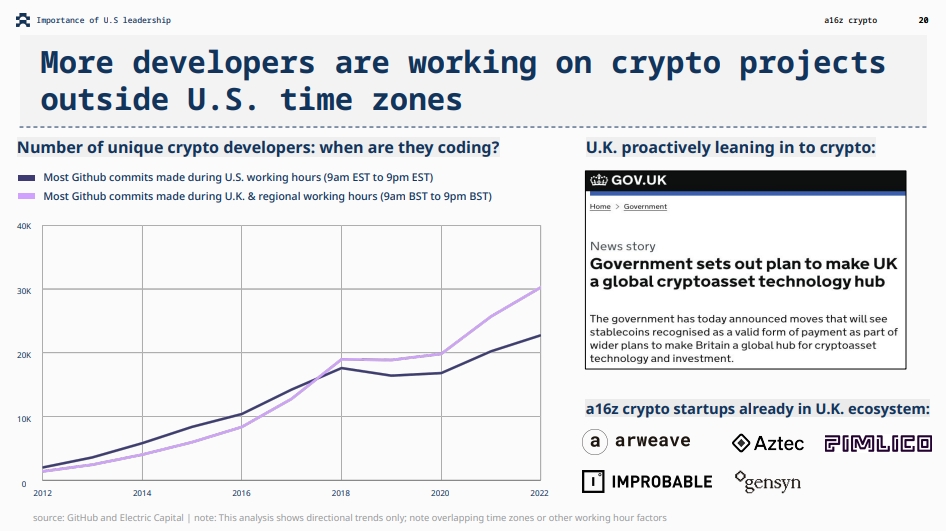
Like semiconductors, the crypto industry may soon move away from the U.S.
In terms of industry innovation, the historical lesson we have learned is: taking semiconductors as an example, in todays manufacturing industry, the United States should not rely on foreign suppliers of key technologies. Excessive scale dependence on infrastructure will have an impact on our daily lives. Likewise, the United States should take the lead on where distributed computing infrastructure (the Internet, organizations, work) goes in the future.
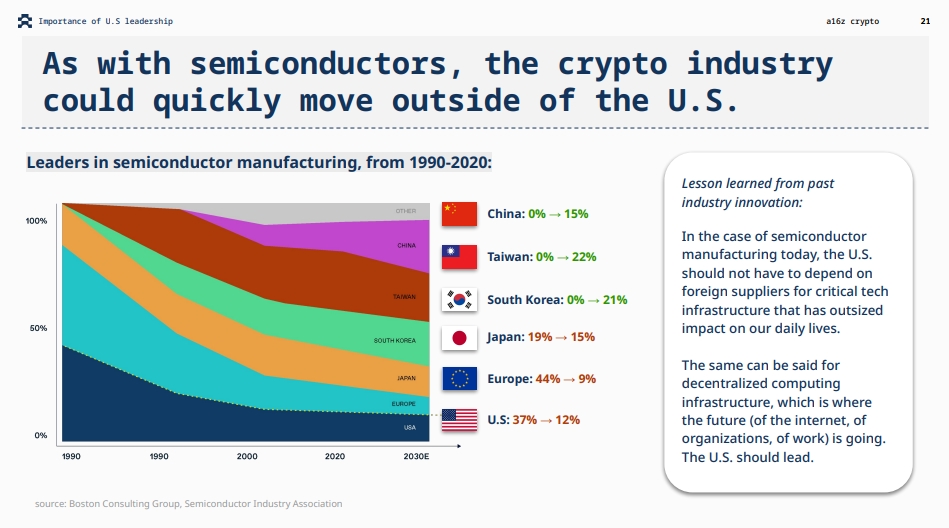
The status of the US dollar is under threat from sovereign digital currencies
Current status of global central bank digital currency (CBDC): The development of China’s central bank digital currency (CBDC) has posed a threat to the US dollar’s status as the world’s currency. As of June 2023, the total number of transactions involving digital renminbi reached US$250 billion.
Stablecoin innovation could strengthen dollar dominance
What is a stablecoin? A stablecoin is a cryptocurrency whose price is nominally “pegged” to a stable asset, such as the U.S. dollar. [For more information on collateral types, see this article in the Financial Timesarticle. ] Stablecoins could help make the U.S. payments system more efficient and solidify the U.S. dollar’s status as a global digital currency.
This is not just about protecting Silicon Valley startups, but also about maintaining America’s global leadership. One way America can win is by leveraging free markets, rather than a centralized planning approach. This bottom-up approach will lead to many new experiments and innovations. This may be the only way to defeat the central bank digital currency (CBDC) of countries such as China.
Part Three: Policy Principles and Framework
U.S. policies that incentivize innovation can protect consumers and provide companies with a path to compliance
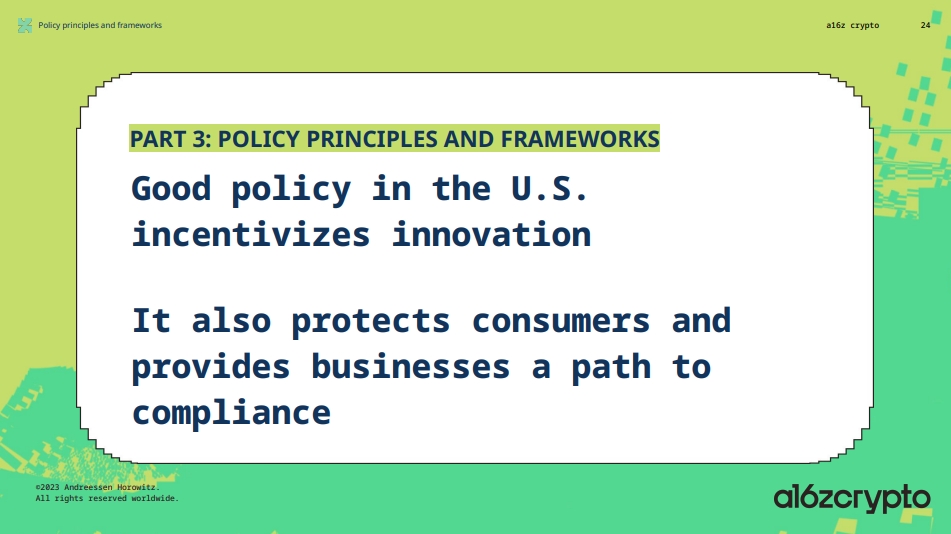
Regulatory activities remain primary focus
a. Cryptocurrency legislation passes House committee for first time in history:
《Committees Introduce Financial Innovation and Technology for the 21 st Century Act” from Rep. French Hill, R-AR, Glenn"GT"Thompson R-PA and Dusty Johnson R-SD.
《Clarity for Payment Stablecoins Act of 2023 ”, Rep. Patrick McHenry of North Carolina.
b. The courts are making a number of decisions in influential cases:
Court Rules in SEC/Ripple Enforcement Action; SEC Dismisses Claims Against Individuals and Appeals Trial Court’s Legal Decision.
c. Government agencies are proposing new rules
The U.S. Internal Revenue Service’s (IRS) proposed rule on reporting requirements for digital asset brokers;
U.S. Commodity Futures Trading Commission (CFTC) Notice of Proposed Rulemaking Regarding Self-Certification of Derivatives Contracts;
FinCEN Proposed Rulemaking Regarding Convertible Virtual Currency Mixers Notifies SEC to Consider Proposal;
Amendment to the Guardianship Rules; also the definition of “exchange”;
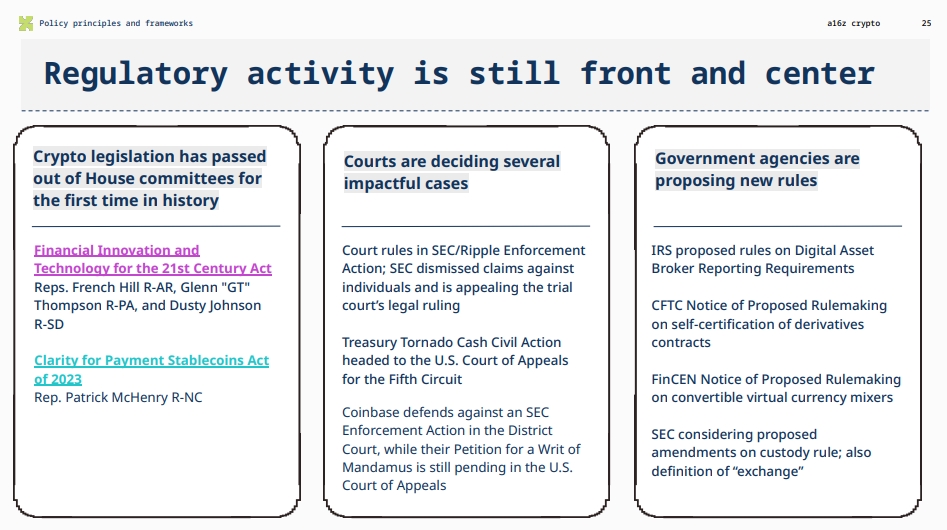
Good regulation can clamp down on bad actors and protect consumers
Former lawmakers, agency heads and others advise U.S. lawmakers to do three things:
a. Protect consumers: Require centralized company registration and supervision: Regulators should investigate risks arising from custody relationships, conflicts of interest, and the use of digital assets in illicit finance.
b. Provide a compliance pathway: Any legislation should provide a disclosure-based compliance pathway for entrepreneurs who have been building decentralized networks and legitimate businesses despite the uncertain environment.
c. Incentivize community ownership: Laws and regulations should appropriately incentivize decentralization and community ownership - this is the core promise of web3 technology to benefit the public and pave the way for future innovation.
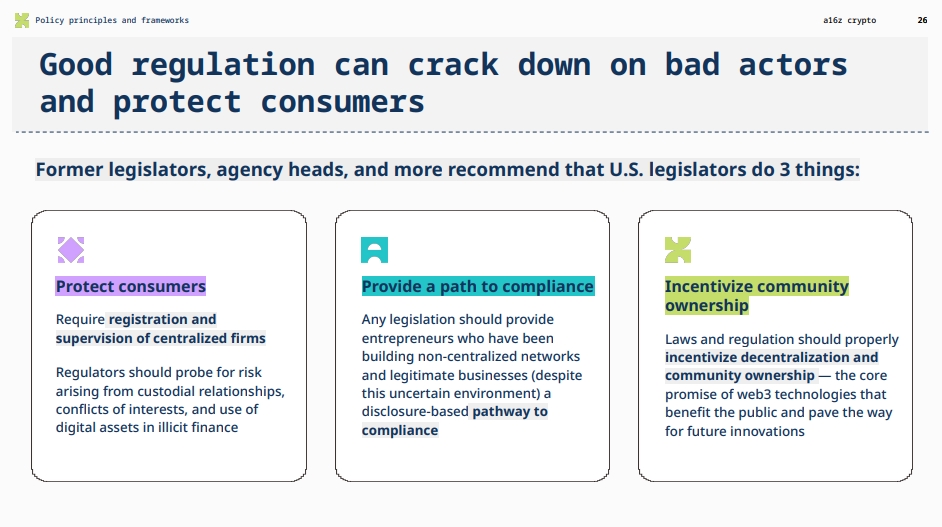
Guiding Principles and Regulations for U.S. Cryptocurrency Policy
a. Banning new business models or technologies harms American values and drives innovation and jobs elsewhere.
b. Institutional guidance and legislation establishing appropriate and clear rules. This not only protects consumers but also helps promote healthy competition for all, including by allowing new innovators to counter the regulatory power of entrenched centralized players and incumbents.
c. Legitimate businesses and their customers should have access to financial services and legal protections – from banking relationships to data privacy.
d. Enterprises should be the focus of regulation, rather than the broad, decentralized, autonomous software that provides the basis for innovation. (Governance application, not protocol)
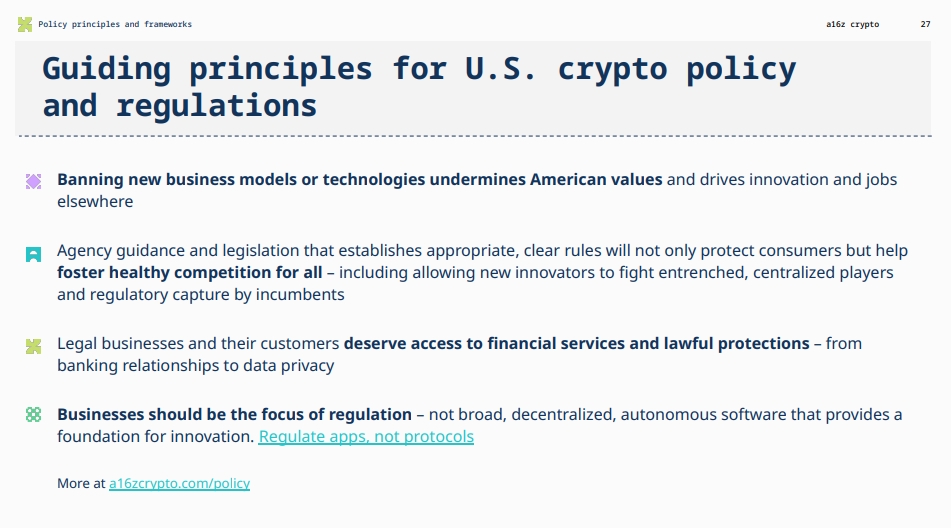
Myth: Cryptocurrencies are only used for illegal activities
Total trading volume and illegal trading volume
Blockchain analytics firms estimate that illegal transactions account for less than 2% of total cryptocurrency activity. As of 2022, such activity will account for approximately 0.10-0.24% of all cryptocurrency activity.
There is far more money laundering through fiat currencies than through cryptocurrencies. It is expected that by 2021, the annual amount of cryptocurrency laundering in traditional financial markets will reach 100-250 times [Source: Nasdaq Anti-Financial Crime Technology Leader]
Fiat money laundering methods (cash, bank wires, real estate, etc.) far outnumber cryptocurrencies in both volume and percentage.
Fact: Cryptocurrencies can help fight crime
Criminals still prefer traditional financial products and services to cryptocurrencies. While criminals and terrorists are looking for any available means, including emerging technologies, to fund and conduct their activities, the U.S. Department of the Treasury’s 2022 National Terrorism Financing Risk Assessment found that compared to other countries, the use of “limited other Financial products and services” – blockchain’s traceability inherently disadvantages these groups.
Blockchain is public, traceable, and immutable. This makes them useful in investigations, prosecutions and asset recovery. Fiat currency, especially cash, is difficult to trace and is still used more frequently for criminal activity.
Cryptocurrencies play a role in fighting crime. In contrast, law enforcement is very effective at tracking cryptocurrency activity (using sophisticated analytical tools), and governments have proven their ability to recover funds this way.
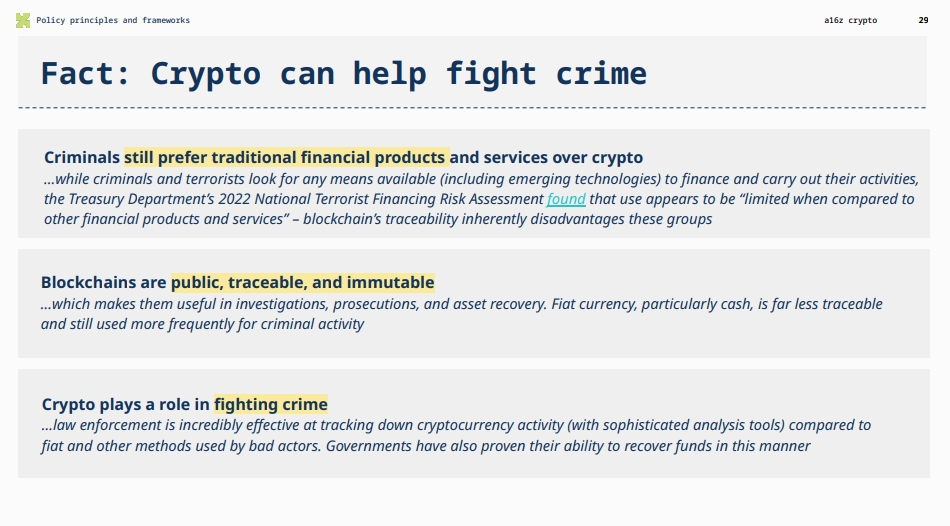
Myth: All cryptocurrencies are harmful to the environment
Estimated annual energy consumption by product/industry
Other industries and companies currently consume far more energy than Ethereum. Why? In September 2022, Ethereum moved to a PoS (Proof of Stake) consensus mechanism (on which many developers chose to build applications), resulting in a 99.9% reduction in energy consumption. All blockchains require such a consensus mechanism because they are decentralized; the PoS method network consensus consumes much less energy than the PoW (Proof of Work) method used by Bitcoin.
